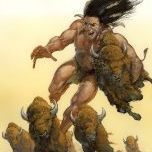-
Posts
422 -
Joined
-
Last visited
Reputation
216 GoodProfile Information
-
Gender
Male
-
Location
Malaysia
-
Interests
Aeroplanes, Bible, Fulham Football Club.
Recent Profile Visitors
1,680 profile views
-
I believe you are right that the "him" in v 40 should refer to the king in v 36 and not to either KOTN or KOS. It is a third king. I suspect it refers to a Roman king, which I believe is the traditional view. Otherwise the prophecy would jump from Antiochus to the end time without referring to the Roman period. I don't think this is an option considering that the fall of Jerusalem was far more devastating to the Jews than what they faced under Antiochus.
-
I think the only way to make sense to these dates is to read them symbolically. Many dates in prophecy are symbolic. So I think the 1260 days represents the centuries of suffering for the Jews since AD70 until 1948 when Israel became a nation again. The next 30 days represents a complete month, i.e. a much shorter but complete period, between 1948 to the start of the Great Tribulation. And the last 45 days represent the period of the Great Tribulation, which is a complete month plus an incomplete second month which shows God will cut short those days for the sake of the elect. Since the periods are symbolic, we should not infer that the 45 days will actually be longer than the 30 days.
-
I agree with Adstar. One reason for the millennium is so that some of the OT prophecies about Israel which have yet to be fulfilled can finally come about. This is one of them.
-
Whatever John is meant to prophesy again, the point is that we are not told what it is. It may be the rest of Revelation but that is an interpretation. Your contention was that we are not told the measurement of the temple. Hence there is no difference; we need to interpret both. I think it is obvious John intends the temple literally. First, 'temple' elsewhere in Revelation is always literal. Second, a measuring rod is always used to measure literal distances (see esp 21:15). Third, the altar always furnishes a literal temple in Rev. I don’t think John can make it any more plain. If we spiritualise the temple, we also have to spiritualise the measuring rod, the altar, the outer court, etc.. The more things that are spiritualised, the more forced and less convincing the interpretation becomes. Btw, why not spiritualise the 42 months and the two witnesses too? Not doing so makes the choice arbitrary and again raises the question of consistency.
-
Are we told what John is to prophesy again in 10:11? If the temple were the body of Christ, are we told its 'measurement'?
-
So are the war, famine and plague in ch 6 but each is preceded by the opening of seals in heaven.
-
How would equating the temple in verse 1 with the temple in heaven conflict with that interpretation of verse 2?
-
How do you interpret 11:2?
-
John uses the word 'temple' several times in Revelation. All the other references up till ch 20 refer to God's temple in heaven. That is probably how it should also be understood in 11:1. It is likely to be the same temple later in v 19.
-
Luke 21:7 clearly says Jesus' disciples asked him when these things will be and what are the signs they are about to take place. Contrary to your assertion, they did not ask him about his second coming and end of the age. "These things" refer back to verse 6 where Jesus predicts that not one stone of the temple will be left on another. It points to the forthcoming destruction of Jerusalem. That is the natural reading and it is probably why interpreters have traditionally and rightly read it that way.
-
The idea of a right number of souls might have come from Rom 11:25 and I think it does mean that God has a certain number of believers that he wants saved before he brings history to a close. He could have created those souls in other ways but he chose to do so through Adam and his descendents. I believe God hoped Adam would stay free of sin - hence the Fall was not a necessity - but Adam failed God. God was nevertheless prepared with a salvation plan in the event Adam failed and so the Fall came as a disappointment but not a surprise to God. This is where we are now.
-
I believe you are right that the multitude in Rev 7:9 represents the raptured saints. However, v 14 says they come out of the great tribulation which implies the great tribulation is already in progress when the multitude are extracted. Also, that John places the two witnesses in ch 11 in the midst of his description of the trumpet plagues indicates that those two minister during the period of the trumpet plagues and not earlier.
-
I think the silence denotes the time immediately after the Rapture. All those pesky christians are gone and the world thinks it can enjoy peace and safety for a change (1 Thess. 5:3). But then destruction will come suddenly in the form of the trumpet plagues. Btw, the half hour is a good indication that God lives in time.
-
That verse is used not only in an end-time context in 17:33 but also more generally e.g. in Lk 9:24. Salvation is conditional upon us remaining true to the faith, as Col. 1:23 makes clear.
-
Can those who fail to trust in the Lord alone be classified as Christians? If not, why would the AC persecute them? He knows they are lost anyway. Makes more sense for him to reward them so that Christians might be tempted to follow. Anyway, how do you read the 1,290 days and 1,335 days; what events do they refer to?








